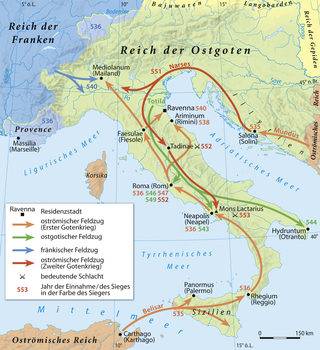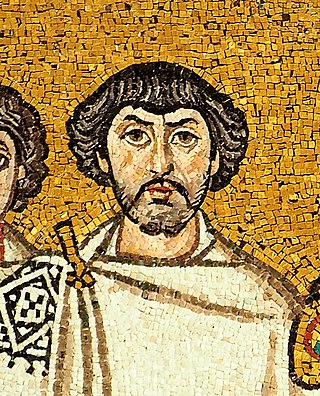Sack of Rome may refer to:
The 540s decade ran from January 1, 540, to December 31, 549.

Year 546 (DXLVI) was a common year starting on Monday of the Julian calendar. The denomination 546 for this year has been used since the early medieval period, when the Anno Domini calendar era became the prevalent method in Europe for naming years.

Year 552 (DLII) was a leap year starting on Monday of the Julian calendar. The denomination 552 for this year has been used since the early medieval period, when the Anno Domini calendar era became the prevalent method in Europe for naming years.

Year 542 (DXLII) was a common year starting on Wednesday of the Julian calendar. From this year forward, the appointment of particular Roman consuls was abandoned and the office was merged with that of Byzantine emperor. Thus, the consular year dating was abandoned in practice, even though it formally remained until the end of the 9th century. The denomination 542 for this year has been used since the early medieval period, when the Anno Domini calendar era became the prevalent method in Europe for naming years.

Narses was, with Belisarius, one of the great generals in the service of the Byzantine Emperor Justinian I during the Roman reconquest that took place during Justinian's reign. Narses was a Romanized Armenian. He spent most of his life as an important eunuch in the palace of the emperors in Constantinople.

Totila, original name Baduila, was the penultimate King of the Ostrogoths, reigning from 541 to 552 AD. A skilled military and political leader, Totila reversed the tide of the Gothic War, recovering by 543 almost all the territories in Italy that the Eastern Roman Empire had captured from his Kingdom in 540.

The Sack of Rome, then part of the Papal States, followed the capture of Rome on 6 May 1527 by the mutinous troops of Charles V, Holy Roman Emperor, during the War of the League of Cognac. Charles V only intended to threaten military action to make Pope Clement VII come to his terms. However, most of the Imperial army were largely unpaid. Despite being ordered not to storm the city, they broke into the scarcely defended city and began looting, killing, and holding citizens for ransom without any restraint. Clement VII took refuge in Castel Sant'Angelo after the Swiss Guard were annihilated in a delaying rear guard action; he remained there until a ransom was paid to the pillagers.

This is a chronology of warfare between the Romans and various Germanic peoples. The nature of these wars varied through time between Roman conquest, Germanic uprisings, later Germanic invasions of the Western Roman Empire that started in the late second century BC, and more. The series of conflicts was one factor which led to the ultimate downfall of the Western Roman Empire in particular and ancient Rome in general in 476.

The Gothic War between the Byzantine Empire during the reign of Emperor Justinian I and the Ostrogothic Kingdom of Italy took place from 535 to 554 in the Italian Peninsula, Dalmatia, Sardinia, Sicily, and Corsica. It was one of the last of the many Gothic Wars against the Roman Empire. The war had its roots in the ambition of the Byzantine emperor Justinian I to recover the provinces of the former Western Roman Empire, which the Romans had lost to invading barbarian tribes in the previous century, during the Migration Period.
Battle for Rome may refer to:
The First Siege of Rome during the Gothic War lasted for a year and nine days, from 2 March 537 to 12 March 538. The city was besieged by the Ostrogothic army under their king Vitiges; the defending East Romans were commanded by Belisarius, one of the most famous and successful Roman generals. The siege was the first major encounter between the forces of the two opponents, and played a decisive role in the subsequent development of the war.
Siege of Rome may refer to:

The sack of Rome in 546 was carried out by the Gothic king Totila during the Gothic War of 535–554 between the Ostrogoths and the Eastern Roman Empire. Totila was based at Tivoli and, in pursuit of his quest to reconquer the region of Latium, he moved against Rome. The city endured a siege lasting almost a year before falling to the Goths.

Belisarius was a military commander of the Byzantine Empire under Emperor Justinian I. Belisarius was instrumental in the reconquest of much of the Mediterranean territory belonging to the former Western Roman Empire, which had been lost less than a century prior. He is considered one of the greatest military commanders in history and the greatest of all Byzantine generals.

The city of Rome was besieged in AD 549–550 by the Ostrogoths, led by Totila, during a campaign to recapture Italy from the Byzantine Empire. After Totila imposed a blockade, soldiers from the city's garrison opened the gates to the Ostrogothic army. Many of Rome's male inhabitants were killed in the city or while attempting to flee—further reducing Rome's population which had collapsed in recent decades.

The following outline is provided as an overview of and topical guide to Rome:

Totila is an opera by Giovanni Legrenzi, written in 1677 to a libretto by Matteo Noris and first performed at the Teatro Santi Giovanni e Paolo in Venice. Another opera called ”Totila in Roma”, based on the same libretto, was written by Francesco Gasparini and first performed at the Teatro Santa Cecilia in Palermo
Battle of Rome may refer to: